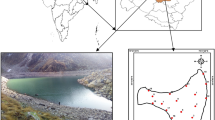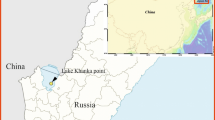Abstract
In this study, an attempt has been made to work out water balance, determine rate of sedimentation and physico-chemical analysis of the lake water. The water balance is carried out using the mass balance equation to account for various input and output components. Sedimentation rates and pattern are estimated using 137Cs and 210Pb radiometric dating techniques. The physico-chemical analysis of the lake water is done by collecting samples from twelve locations of the lake at three different depths. The major inflow to the lake is catchment runoff, which accounts for nearly 56% of the total annual inflow and about 98% inflow takes place during monsoon period. The major outflow from the lake is weir overflow, which occurs in monsoon season only and accounts for about 85% of the total annual outflow. The estimated mean sedimentation rate in the lake is 0.58 ± 0.028 cm/year. The estimated useful life of the lake based on post-1964 (appearance of the major peak of 137Cs due to weapon fallout record pattern) average sedimentation rate is around 467 ± 23 years. The lake has attained the hyper-eutrophic state due to high nitrogen and phosphorous contents in the lake water. Based on the trophic state index (TSI), the lake has become unsuitable for drinking, bathing and even for fish culture.
Similar content being viewed by others
References
Adoni, A. D. (1975). Studies on microbiology of Sagar lake. Ph.D thesis, Dr. H.S. Gour Vishwavidyalaya, Sagar, India.
APHA (1985). Standard methods for the examination of water and wastewater, 15th ed. New York: American Public Health Association.
Awatramani, M. G. (1980). Limnological studies of Sagar lake. Sagar. Ph.D thesis, Dr. H.S. Gour Vishwavidyalaya, Sagar, India.
Carlson, R. E. (1977). A trophic state index for lakes. Limnology and Oceanography, 22(2), 361–369.
Crickmore, M. J., Tazioli, G. S., Appleby, P. G., & Oldfield, F. (1990). The use of nuclear techniques in sediment transport and sedimentation problems. Technical Document in Hydrology. Paris: UNESCO.
Das, B. K., Singh, M., & Borkar, M. D. (1994). Sediment accumulation rate in the lakes of Kumaun Himalaya, India using 210Pb and 226Ra. Environmental Geology, 23, 114–118.
Eakins, J. D. (1983) The 210 Pb technique for dating sediments and some applications. IAEA-TECDOC-298, Radioisotopes in Sediment Studies, Vienna, pp. 31–47.
Jain, C. K., & Bhatia, K. K. S. (1988). Physico-chemical analysis of water and wastewater. User’s Manual, National Institute of Hydrology, Roorkee, India.
Jenne, E. A., & Wahlberg, J. S. (1968). USGS Prof Paper, 433-F, 16p.
Krishnaswami, S., & Lal, D. (1978). Radionuclide Limnochronology. In A. Lerman (Ed.) Lakes: chemistry, geology and physics (pp. 153–173). New York: Springer.
Kumar, B., Nachiappan, RmP., Rai, S. P., Kumar, U. S., & Navada, S. V. (1999). Improved prediction of life of a Himalayan lake. Mountain Research and Development, USA, 19(2), 113–121.
Kumar, B., Rai, S. P., Nachiappan, RmP., Singh, S., Diwedi, V. K., Mani, P., et al. (2005). Evaluation of recent trends of sedimentation in Indian lakes using 210Pb and 137Cs dating techniques. In K. K. S. Bhatia, & S. D. Khobragade (Eds.) Urban lakes in India: conservation, management and rejuvenation (pp. 135–145). Roorkee, India: NIH.
Kusumgar, S., Agarwal, D. P., & Sharma, P. (1989). Radiocarbon chronology and magnetic susceptibility variation in Kumaon Lake sediments. Radiocarbon, 31(3), 957–964.
Livingston, D., & Cambray, R. S. (1978). Confirmation of 137Cs dating by algal stratigraphy in Rosthene Mere. Nature, 276, 259–261.
McHenry, J. R., Ritchie, J. C., & Gill, A. C. (1973). Accumulation of 137Cs in soils and sediments in selected watersheds. Water Resources Research, 9, 676–686.
Reokhow, K. H., & Chapra, S. C. (1983). Lake quality indices, engineering approaches for lake management, vol. 1. London: Butterworth Publishers.
Robbins, J. A., & Edgington, D. N. (1975). Determination of recent sedimentation rates in Lake Michigan using 210Pb and 137Cs. Geochimica Et Cosmochimica Acta, 39, 285–304.
Ryding, S. O., & Rast, W. (1989). Chapter on selection of effective strategies for the management eutrophication. In S. O. Ryding, & W. Rast (Eds.)The control of eutrophication of lakes and reservoirs (Vol. 1). Carnforth, U.K.: UNESCO, Paris and Parthenon Publishing Group Ltd.
Yadav, M. (1986). Qualitative and quantitative analysis of macrophytes and macrofauna. Ph.D thesis, Dr. H.S. Gour Vishwavidyalaya, Sagar, India.
Yatheesh, S. (1990). Study of the trophic status of the Sagar lake with special reference to the macrobenthic invertebrates. Ph.D thesis, Dr. H.S. Gour Vishwavidyalaya, Sagar, India.
Author information
Authors and Affiliations
Corresponding author
Rights and permissions
About this article
Cite this article
Singh, S., Kumar, B., Thakural, L.N. et al. A comprehensive study on water balance, sedimentation and physico-chemical characteristics of Sagar Lake in India. Environ Monit Assess 148, 265–276 (2009). https://doi.org/10.1007/s10661-008-0157-1
Received:
Accepted:
Published:
Issue Date:
DOI: https://doi.org/10.1007/s10661-008-0157-1




